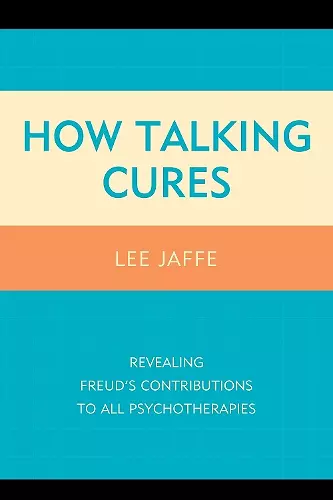How Talking Cures
Revealing Freud's Contributions to All Psychotherapies
Format:Hardback
Publisher:Rowman & Littlefield
Published:20th Aug '14
Currently unavailable, and unfortunately no date known when it will be back

Sigmund Freud repeatedly revised his understanding of how our minds work, how to understand mental illness, and how to relieve emotional, psychological suffering. With each revision, however, he did not methodically integrate previous ideas with newer ones. In How Talking Cures: Revealing Freud's Contributions to All Psychotherapies, a careful review of his concepts at each stage of his thinking reveals six different ways that talking cures—six distinct generic modes of therapeutic action by which all present-day psychotherapies work. Lee Jaffe demonstrates how these therapeutic actions can link treatment recommendations to individual diagnoses, and how they function during treatment itself. Different views of how psychoanalytic treatments work are analyzed according to their emphasis or de-emphasis of these six modes of therapeutic action. As a result, comparisons of all approaches to talking cures, and decisions about the choice of treatment for a given patient can be grounded in an understanding of the essential ways that each therapeutic procedure works, rather than an allegiance to what providers happened to be taught during their training.
Jaffe offers a brief but brilliant account of the ways in which the elements of Freudian therapeutic action play out in both individual and couples therapy. Jaffe identifies six generic modes of therapeutic action in the writings of Freud: direct support, introjection, catharsis, insight, identification, and working through. These six modes account for the change process in psychoanalysis, and some combination of them accounts for the mutative process in most psychotherapies, including the popular cognitive-behavioral therapy. The brevity of this account of psychotherapeutic action—the book comprises six chapters (one an introduction) plus a preface and a conclusion—makes it eminently suitable for teaching mental health professionals, whether psychoanalytically inclined or not. Students of psychology, psychoanalysis, and social work will find this an indispensable introduction to diagnosis and treatment. Summing Up: Highly recommended. Upper-division undergraduates throufh faculty and professionals; general readers. * CHOICE *
This is a book about the relevance of Freudian ideas to psychotherapy for the student of psychotherapy and the generalist psychotherapist. The book has value as a primer about how psychotherapy, seen through a Freudian lens, works. In that way, it will contribute to attuning therapists to a way of thinking about the processes with which they work. The book may serve as a guide... to the treatment planning process. Given that psychoanalysis is out of favor in many quarters these days, this book has value as a way of demonstrating that psychoanalytic concepts have relevance in today’s world of diverse psychotherapies. * PsycCRITIQUES *
How Talking Cures is a real how-to book, valuable to all psychotherapists - whether they work with children , adolescents, adults, or couples, whether they practice behavioral techniques or insight-oriented therapy, including transference interpretation. It is also an invaluable aid to teachers. In fact, Jaffe's talent for explaining and extending Freud's basic ideas shines through. . . .I especially recommend How Talking Cures to beginning therapists and to those therapists who use behavioral techniques, for I think it will entice them to want more. * The Psychoanalytic Quarterly *
How Talking Cures shows the value of most psychoanalytic concepts and how they can fit together into an encompassing model of mutative action. Dr. Jaffe emphasizes Freud as the originator of psychoanalytic ideas, and like Leo Rangell, Jaffe sees the body of Freud’s work as the means to integrate all the various ideas about how psychoanalysis cures. This book shows how these models of mutative action are relevant to most psychotherapies, not just traditional psychoanalysis. It demonstrates their relevance with compelling and concrete examples making it useful for teaching psychiatric residents as well as graduate students in the many disciplines tasked with treating mental health problems. It is also useful for beginning psychoanalytic candidates and can set the stage to avoid polarizing debates about different psychoanalytic schools. -- Alan Sugarman, PhD, University of California, San Diego
Dr. Jaffe’s new book—‘How Talking Cures…’ —is a masterpiece. The book successfully integrates Freud’s thinking across several domains of psychotherapy. Jaffe clearly and consistently demonstrates the cardinal utility of Freud’s thinking so that those familiar with Freud may be surprised just how useful it is outside so-called ‘pure’ psychoanalysis. Those new to the subject may be surprised to find how familiar the clinical descriptions appear, now almost eight decades after Freud’s death. This book will be a valuable asset to therapists of any theoretical persuasion who are willing to expand their technical and theoretical horizons. -- Robert L. Tyson, MD, Seattle Psychoanalytic Society and Institute
ISBN: 9781442239890
Dimensions: 235mm x 162mm x 15mm
Weight: 313g
114 pages